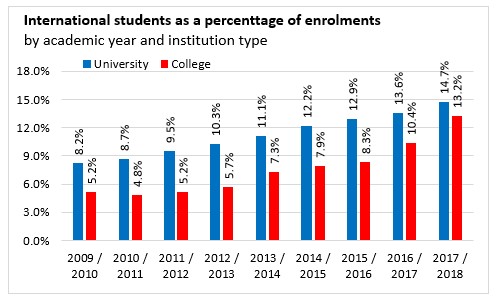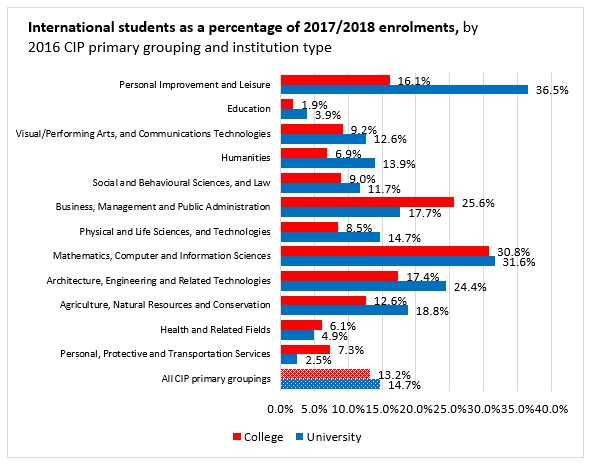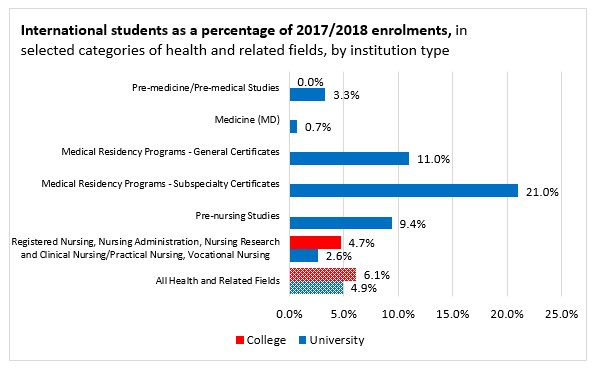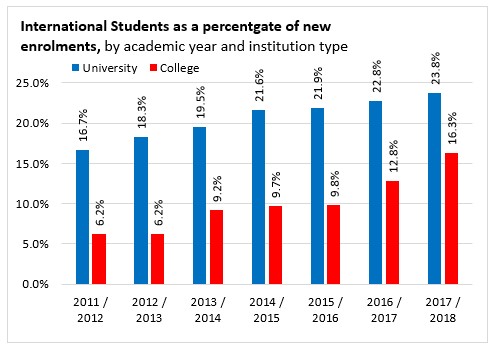The Economics and Statistics Division maintains archives of previous publications for accountability purposes, but makes no updates to keep these documents current with the latest data revisions from Statistics Canada. As a result, information in older documents may not be accurate. Please exercise caution when referring to older documents. For the latest information and historical data, please contact the individual listed to the right.
<--- Return to Archive
For additional information relating to this article, please contact:
June 15, 2020STUDY: INTERNATIONAL STUDENT ENROLMENT IN POSTSECONDARY EDUCATION PROGRAMS PRIOR TO COVID-19 Today, Statistics Canada released a study that provides information on the share of total university and college enrolments from international students across field of study and source country. Given the ongoing uncertainties around the COVID-19 pandemic and the new public health restrictions imposed on international travel, physical distancing guidelines affecting classroom structures, and the real possibility that many programs may have to be delivered online, the share of enrolments in various academic programs that are international is of high relevance at the moment.
The study is based on the 2017/2018 Postsecondary Student Information System (PSIS), which contains enrolment data from almost all publicly-funded postsecondary institutions in Canada. A very small number of institutions did not report on international students, and thus, are excluded from this study. Fields of study are categorized by the 2016 Classification of Instructional Program (CIP), most often into primary groupings.
While this is the first Canadian study reporting on the share of postsecondary enrolments from international sources by both field of study and source country, a small number of earlier studies examined international student enrolment by field of study (McMullen and Elias 2011; Statistics Canada 2016; Gardner Pinfold 2018) or by source country (The Association of Universities and Colleges of Canada 2011; Statistics Canada 2016; Gardner Pinfold 2018).

Tuition fees have represented an increasing share of revenue for postsecondary institutions in recent years. A recent study showed that the gap between increasing operating expenditures and slower-growing provincial grants increased by $5.9 billion between 2007/2008 and 2016/2017 academic years (Usher, 2019). During the same period, domestic tuition fees generally did not increase more than inflation while domestic enrollment peaked midway through.
International tuition fee revenues increased by $3.25 billion between 2007/2008 and 2016/2017 and accounted for 55 per cent of the increased gap during this period. The share of international enrollment at the university level increased from 8.2 per cent in 2009/2010 to 14.7 per cent in 2017/2018. At the college level, the share of enrolment from international sources increased from 5.2 per cent in 2009/2010 to 13.2 per cent in 20017/2018.
Looking at the field of study, almost one third of enrolments in “Mathematics, Computer and Information Sciences” were international at both the college (30.8 %) and university level (31.6 %).

At the university level, the highest share of international enrolments included “Statistics” (49.5%), “Computational Science” (38.5%), “Mathematics” (37.4%), and “Applied Mathematics” (36.3%). Other broad university programs with relatively high international student enrolment included “Architecture, Engineering and Related Technologies” (24.4%), “Agriculture, Natural Resources and Conservation” (18.8%), and “Business, Management and Public Administration” (17.7%). The share of enrolment from international sources was lowest in “Personal, Protective and Transportation Services” (2.5%), followed by “Education” (3.9%) and “Health and Related Fields” (4.9%).
At the college level, the highest share of international enrolment included “Data Processing and Data Processing Technology/Technician” (65.2%), “Computer Programming” (40.0%), and “Computer and Information Sciences and Support Services, General” (37.2%). Among college programs, rates were lowest in “Education” (1.9%), followed by “Health and Related Fields” (6.1%), “Humanities” (6.9%), and “Personal, Protective and Transportation Services” (7.3%).

Although international enrolment accounted for a small share of university and college programs in “Health and Related Fields”, a relatively large share of medical students were international students in 2017/2018. Specifically, one in five of students registered in “Medical Residency Programs – Subspecialty Certificates” were international students. Among those registered in “Medical Residency Programs – General Certificates”, one in nine (11%) were international students.
International students accounted for a smaller share of total enrolments in “Registered Nursing, Nursing Administration, Nursing Research” (2.6%) or “Clinical Nursing/Practical Nursing, Vocational Nursing and Nursing Assistants” (4.7%) at the university and college levels.
China was the top source of international enrolments in most broad university program areas and topped all countries in 11 of the 12 program areas. China came second only in “Health and Related Fields” just after Saudi Arabia.
One in six of all students in “Mathematics, Computer and Information Sciences” (16.4%) came from China accounting for slightly more than half of all international enrolments in this program area. China accounted for between 7% and 8% of all enrolments in “Architecture, Engineering and Related Technologies”, “Business, Management and Public Administration”, and “Agricultural, Natural Resources and Conservation”.
Across college programs, India was the top source of international enrolment, leading the international enrolments in nine of the 12 broad college programs. India accounted for at least half of all international students in 6 of the program areas. One-fifth (20.0%) of all “Mathematics, Computer and Information Sciences” students were from India, accounting for about two-thirds of all international students in this group. India also accounted for 13.6% of all “Business, Management and Public Administration” students (about half of all international enrolments in this program area), as well as 9.9% of all “Architecture, Engineering and Related Technologies” enrolments (more than half of international enrolment in this broad program area).
In the three program areas where India was not the top source of international enrolments (“Personal Improvement and Leisure”; “Visual and Performing Arts, and Communications”; and “Humanities”), China was the top international source country by a narrow margin.

Given the travel restrictions in place, prospective students may be more likely to change their university choices since they have yet to invest in Canadian postsecondary education. The study shows that international enrolments comprise a larger share of new enrolments than total enrolments. At the university level, 23.8 per cent of new enrolments were international in 2017/2018, compared to 14.7 per cent of total enrolments. In colleges, 16.3 per cent of new enrolments were international in 2017/2018, compared to 13.2 per cent of total enrolments.
As Canadian universities and colleges adopt their plans for the 2020 fall term, the findings on international student enrolments by program of study and source country can help inform policy decisions on international travel restrictions and program delivery platforms.
Source: Statistics Canada, Study: International student enrolment in postsecondary education programs prior to COVID-19
<--- Return to Archive